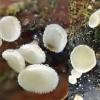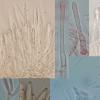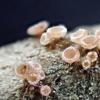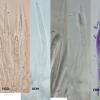
21-12-2025 21:32
Pol DebaenstHello, Garden, Burgweg 19, Veurne, BelgiumOn 10/1

21-12-2025 21:40
Isabelle CharissouBonjour, j'aimerais connaitre les références de

21-12-2025 21:31
Pol DebaenstHello, Garden, Burgweg 19, Veurne, BelgiumOn 10/1

21-12-2025 21:31
Pol DebaenstHello, Garden, Burgweg 19, Veurne, BelgiumOn 10/1

20-12-2025 23:08
Patrice TANCHAUDBonsoir, récolte sur sol sablonneux dans l'arri�

21-12-2025 09:32
Hello.A tiny ascomycete found embedded in wood in

20-12-2025 15:47
Mirek GrycHi.These grew on pine wood that was heavily covere
The hairs are clavate or sometimes tapering, with up to three septa, no droplets and 50-70 x 4-5 µ. The paraphyses have some barely discernible small droplets, the size is 70-90 x 4-6 µ in the living state and they have two or three septa in the lower third, protruding 15-25 µ above the ascus tips. The asci are 8-spored, 40-50 x 4-5 µ. The spores have some vaguely visible droplets and are (6.5) 7.2 - 9.3 (9.6) × (1.5) 1.7 - 2.4 (2.7) µm.
This leads me to Lachnum "subreynoutria". It is once mentioned on ascofrance:
http://ascofrance.com/search_forum/12116
Is the species better known now ten years later or is this someting else?

I have tried to find newer litterature but there seems not to be very many publications on new European Lachnum species or combinations, at least not anything of relevance for this case. I have mostly found only Asian papers, which I have not cheked out in detail.
Unfortunately I forgot the collection on the table to dry overnight, so now it is light brown. Anyhow, I made an attempt with KOH and CRB, photos attached. I also found a yesterday photo in water with paraphyses looking more alive.





